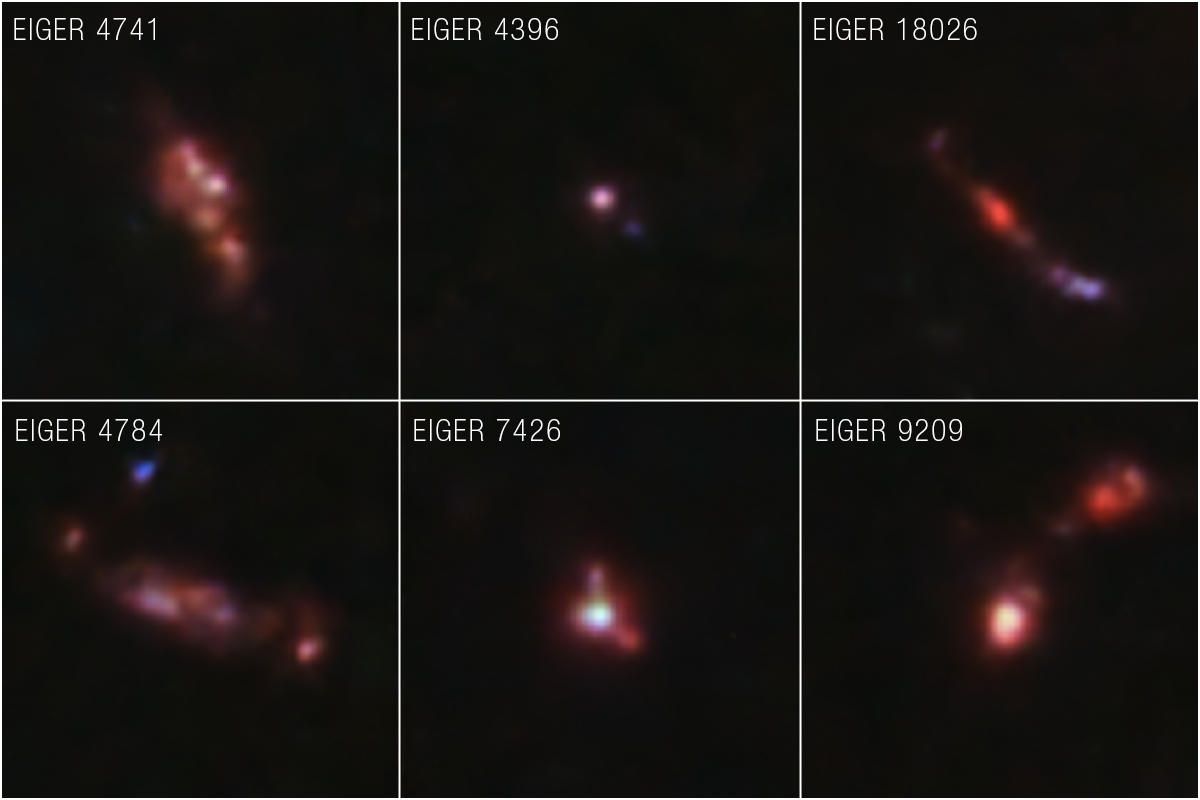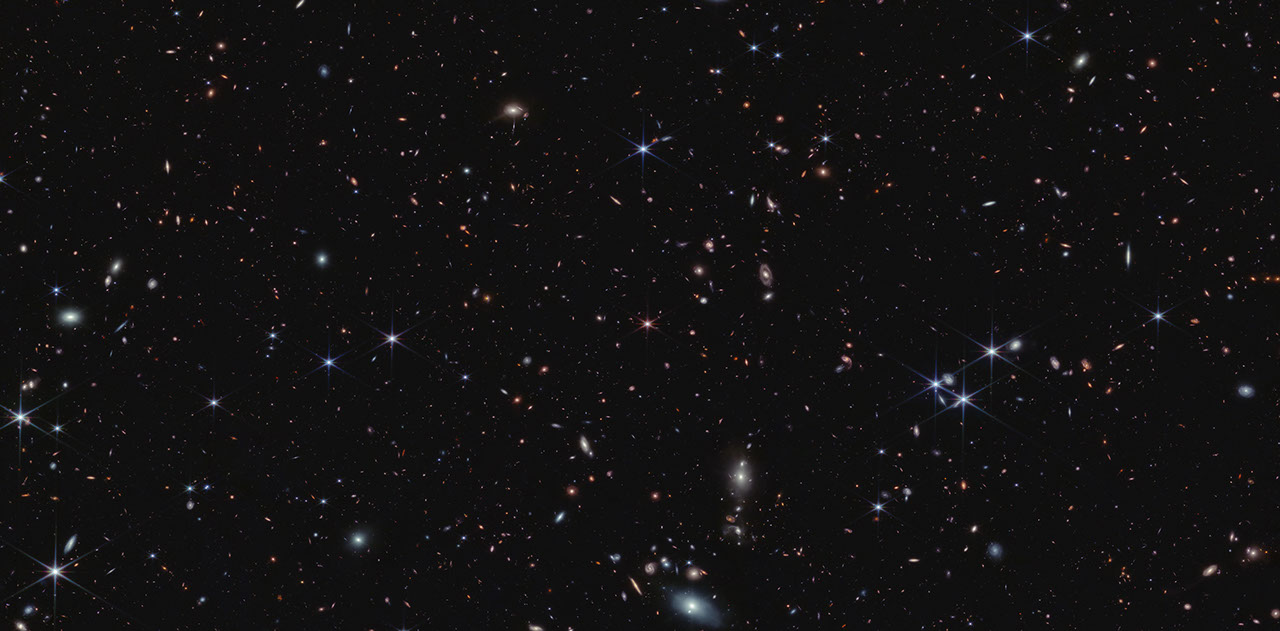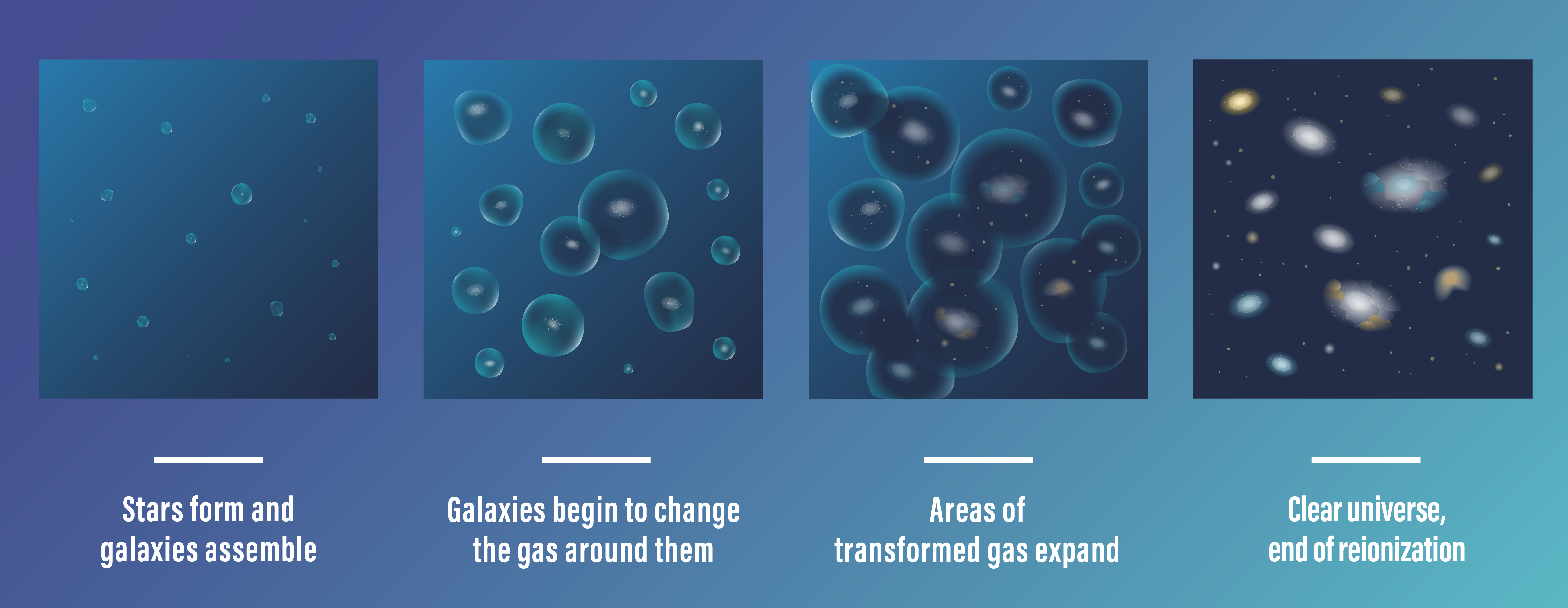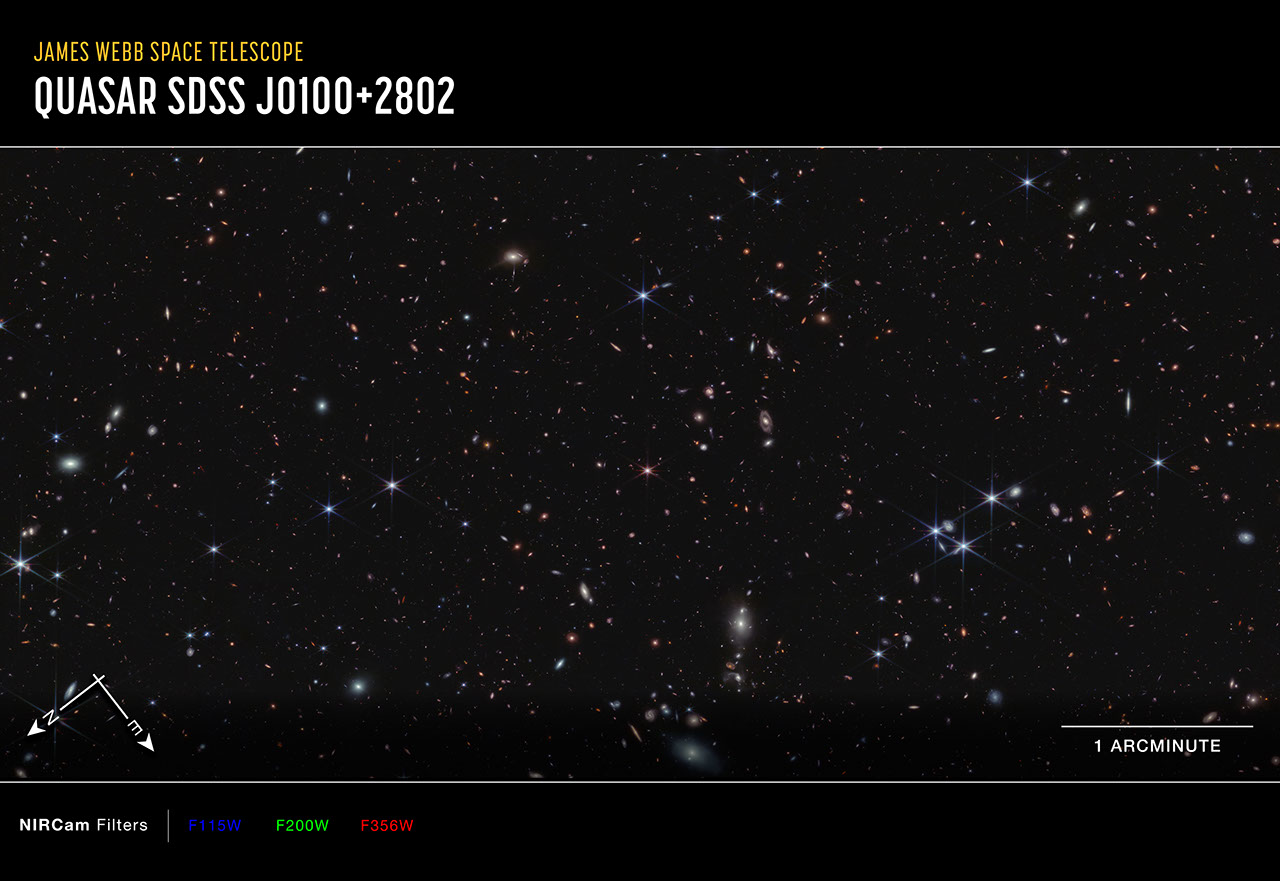1 min read
Distant Galaxy Samples Near Quasar J0100+2802 (NIRCam Image)

The James Webb Space Telescope has returned extraordinarily detailed images and spectra of galaxies that existed when the universe was only 900 million years old. “In Webb’s near-infrared image, we can see structures in every individual galaxy that the telescope detected,” shared Jorryt Matthee of ETH Zürich. “Webb is showing us the adventurous youth of these early galaxies.”
These galaxies look more chaotic than those in the nearby universe – they are clumpy and often elongated. These galaxies are also younger and are actively forming stars. The stars Webb detected are all more massive, which may lead to an abundance of colorful supernovae shooting off in these galaxies.
These results were announced by members of the Emission-line galaxies and Intergalactic Gas in the Epoch of Reionization (EIGER) team. Webb’s NIRCam (Near-Infrared Camera) image and data known as spectra helped the team fully define 117 galaxies in this field.
Extended Description and Image Alt Text
Extended Description
Six galaxies appear in boxes, three by two. White text at the top left of each box label the galaxies. From top left to bottom right:
- EIGER 4741 is made up of six hazy red or pink dots, and takes up about a quarter of the image.
- EIGER 4396 is primarily a hazy pink dot at the center with a very faint, smaller purple dot at its bottom right.
- EIGER 18026 looks like a paintbrush smudge, starting a third of the way from top left and ending about a third of the way from bottom right. The line is faint to start, bright red and bulbous at the center, and links faintly to three smaller purple dots at bottom right.
- EIGER 4784 also takes up a lot of the space. It has many pink and red ovals at the center along a mostly horizontal line, and a red dot and a blue dot appear arching up in a disconnected clockwise spiral shape. There is a red haze from center to the right, with a brighter red dot appearing a little lower at right.
- EIGER 7426 is on the smaller side, and has a larger white circle at center that connects with faint pink lines to a dot above it and one at the four o’clock position.
- EIGER 9209 appears smeared across the space, with a bright, larger red dot with a pink-white center toward the middle with a haze of red above it. The faint line breaks, but points toward a bright red dot at the top right, which also has a hazy red region around it.
Image Alt Text
Six galaxies appear in boxes, three by two. All carry an EIGER label at top left. The galaxies look like faint smudges: faint paintbrush strokes with dots, or small points of light. Most appear in pinks and reds, though a few contain some purple or blue.
About the Object
- R.A. PositionR.A. PositionRight ascension – analogous to longitude – is one component of an object's position.01:00:13.02
- Dec. PositionDec. PositionDeclination – analogous to latitude – is one component of an object's position.+28:02:25.8
- ConstellationConstellationOne of 88 recognized regions of the celestial sphere in which the object appears.Pisces
About the Data
- Data DescriptionData DescriptionProposal: A description of the observations, their scientific justification, and the links to the data available in the science archive.
Science Team: The astronomers who planned the observations and analyzed the data. "PI" refers to the Principal Investigator.This image was created with Webb data from proposal: 1243 (S. Lilly)
- InstrumentInstrumentThe science instrument used to produce the data.NIRCam
- Exposure DatesExposure DatesThe date(s) that the telescope made its observations and the total exposure time.22 Aug 2022
- FiltersFiltersThe camera filters that were used in the science observations.F115W, F200W, F356W
- Object DescriptionObject DescriptionThe type of astronomical object.Galaxy OIII Emitters
- Release DateJune 12, 2023
- Science ReleaseNASA’s Webb Proves Galaxies Transformed the Early Universe
- CreditImage: NASA, ESA, CSA, Simon Lilly (ETH Zurich), Daichi Kashino (Nagoya University), Jorryt Matthee (ETH Zurich), Christina Eilers (MIT), Rongmon Bordoloi (NCSU), Ruari Mackenzie (ETH Zurich); Image Processing: Alyssa Pagan (STScI), Ruari Mackenzie (ETH Zurich)

These images are a composite of separate exposures acquired by the James Webb Space Telescope using the NIRCam instrument. Several filters were used to sample wide wavelength ranges. The color results from assigning different hues (colors) to each monochromatic (grayscale) image associated with an individual filter. In this case, the assigned colors are: Blue: F115W Green: F200W Red: F356W
Related Images & Videos

Quasar J0100+2802 (NIRCam Image)
There are more than 20,000 galaxies in this field. This James Webb Space Telescope view is found between the Pisces and Andromeda constellations. Researchers using Webb anchored their observations on quasar J0100+2802, an active supermassive black hole that acts like a beacon....

Conditions During the Era of Reionization (Illustration)
More than 13 billion years ago, during the Era of Reionization, the universe was a very different place. The gas between galaxies was largely opaque to energetic light, making it difficult to observe young galaxies. As stars and young galaxies continued to form and evolve, they...

Quasar J0100+2802 (NIRCam Compass Image)
This image centered on quasar J0100+2802, captured by Webb’s NIRCam (Near-Infrared Camera), shows compass arrows, scale bar, and color key for reference. The north and east compass arrows show the orientation of the image on the sky. Note that the relationship between north and...
Share
Details
Laura Betz
NASA’s Goddard Space Flight Center
Greenbelt, Maryland
laura.e.betz@nasa.gov
NASA, ESA, CSA, Simon Lilly (ETH Zurich), Daichi Kashino (Nagoya University), Jorryt Matthee (ETH Zurich), Christina Eilers (MIT), Rongmon Bordoloi (NCSU), Ruari Mackenzie (ETH Zurich)
Alyssa Pagan (STScI), Ruari Mackenzie (ETH Zurich)




























